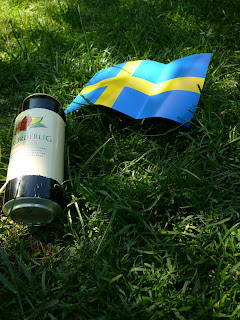Swedish National Day: Strawberries, Flags and Underwear
 The symbols of Swedish-ness to me: the flag and Rekorderlig cider next to each other on the grass in Uppsala City Gardens.
The symbols of Swedish-ness to me: the flag and Rekorderlig cider next to each other on the grass in Uppsala City Gardens.When comparing the ways of celebrating the National Day of Sweden (6th June) and the Independence Day of Finland (6th December), one can notice that they could not differ more. Certainly the time of the year already sets some limits: when Finnish ‘celebrate’ during one of the most depressing times of the year, when it’s sleeting and dark outside, the Swedish have a nice out-door picnic in the sun when the lightest days and the whole summer is still ahead. Perhaps it orientates the ‘national mind’ as well: when Finns are expecting the bad days and closing into themselves (‘things will only get worse, we have to prepare for everything’), Swedes think positively because the future looks so bright for them!
Besides the time of the year, the general mood of the celebration is very different. Most probably my few hours’ observations give only a faint picture of the Swedish festivities, but it seemed like most people spent their day off today with their friends and families, gathering in parks or in their homes. Everything seemed just so mysigt – the closest translation for that in English would be something like cozy or comfortable. The park was clearly a showcase for young people in their 20s or 30s: half of the young men were going about topless, presenting their abdomen muscles and playing football, and half of the women wore only their bra, contenting themselves chatting on the grass. So, when Swedes come happily together, sing songs and sunbathe in their underwear in the parks, Finns have gloomy candle marches to the veterans’ graves during the day. In the evening the whole nation sits in front of the TV, watching the ball with politicians and celebrities in the president’s castle. Sounds jolly, doesn’t it?
The official National Day programme included loads of speeches amongst the songs and orchestral pieces performed in the City Garden of Uppsala. Most of the words slipped past my ears, but I heard some intriguing parts of speech while having my sojakorv (soya-sausage in a bun) and jordgubbar (‘earth hubbies’, strawberries) in the park. The National Day is dedicated to all new Swedish citizens of the year (something I cannot imagine happening in Finland, even on the official discourse level: dedicating the Independence Day to immigrants!), and this year it was 100 years from the birth of Gösta Knutsson, the author of Pelle Svanslös (in Finnish Pekka Töpöhäntä, in English ‘the cat without a tail’). The speaker, an elderly man, was handy combining these two things casually by urging the new Swedes to read Gösta Knutsson in order to learn more about Swedish culture. This was topped with a child choir, masqueraded as cats and singing songs of Pelle Svanslös. Another phrase I heard was about
On the whole, the festivities were not very extravagant, at least compared to yesterday’s new high school graduates who celebrated their studenten. White-capped (caps which remind foreigners of sailors’ hats, I’ve been told) bright-eyed hopes of

Comments